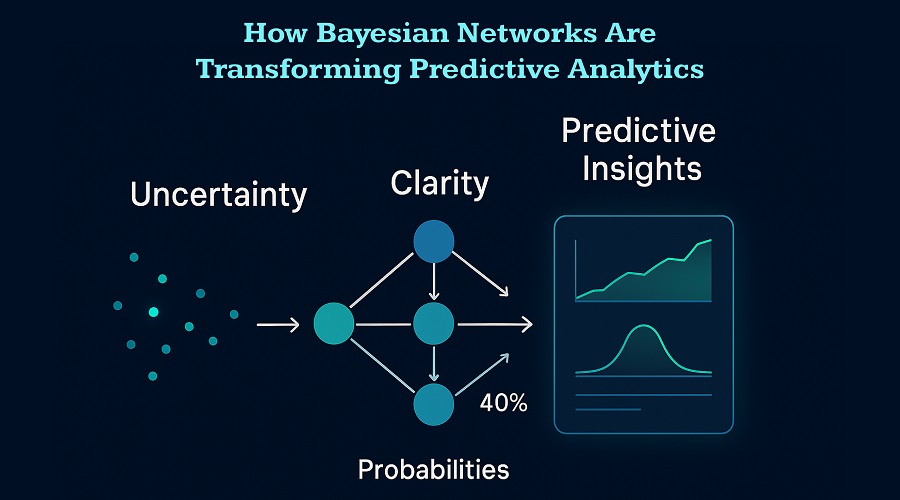Just imagine that you could look at a problem, view all of the interlinkages between causes and outcomes, and make very accurate forecasts. That is exactly what Bayesian Networks are doing with predictive analytics today. From diagnosis of disease to prediction of customer churn, these advanced probabilistic models are creating data insightful information at rapid, intelligent, and trustworthy velocities.
Let us examine how Bayesian Networks are redefining predictive analytics, distinctive things that set them apart, and why enterprises and data scientists are gravitating toward them with data being such a dominant force today.
What Are Bayesian Networks?
At its most basic level, Bayesian Networks (which are also called belief networks or probabilistic graphical models) are mathematical models that outline relationships between variables using nodes and edges. The variables themselves are nodes, while edges tell us how variables affect one another. Where they do diverge, however, is that they are able to approach uncertainty with Bayes’ Theorem.
Instead of categorical and absolute yes/no type rules, Bayesian Networks make probabilistic estimates. For example, instead of that a machine will fail, they estimate failure probability with inputs from sensors, repair history, and environmental conditions.
Why Are Bayesian Networks So Powerful in Predictive Analytics?
Let’s break it down with some real-world relevance:
- They Handle Uncertainty Better Than Traditional Models
Traditional models often need complete and clean datasets. In contrast, Bayesian Networks can work with incomplete data and still produce predictions. This makes them ideal for real-life scenarios where data is noisy or missing.
A study by IBM highlights that 80 percent of the time spent cleaning and organizing data science is spent cleaning. Bayesian methods reduce this burden.
- They Provide Causal Insights, Not Just Correlation
Unlike many machine learning models, Bayesian Networks help understand why something is happening, not just what might happen.
For example, in healthcare, researchers at the University of Manchester used Bayesian Networks to predict cancer progression. The model not only forecasted outcomes but also highlighted key contributing factors like genetic markers and lifestyle choices (Source).
- Easy to Interpret for Humans
Bayesian Networks offer visual diagrams that map out relationships. This interpretability is a huge advantage when decisions involve both technical and non-technical stakeholders, such as in finance or policy making.
Real World Use Cases
- Healthcare
In the field of clinical decision support, Bayesian Networks are helping doctors predict disease risks based on patient symptoms, history, and genetic data.
For example, the U.S. National Library of Medicine published a study showing how these models improved diagnostic accuracy in predicting cardiovascular disease by up to 15 percent.
- Cybersecurity
Bayesian Networks are used in intrusion detection systems to estimate the probability of a cyberattack based on network behavior.
Companies like Cisco are embedding probabilistic models in their security frameworks to identify threats more effectively (Cisco White Paper).
- Manufacturing and Predictive Maintenance
Predicting when equipment might fail can save millions. General Electric (GE) uses Bayesian methods in their Predix platform to forecast failures in turbines and aircraft engines.
- Marketing and Customer Behavior
E-commerce platforms apply Bayesian models to estimate the probability of a customer churning, buying, or responding to an offer - allowing for highly personalized marketing.
According to McKinsey, personalization based on predictive modeling can boost sales by 10 to 20 percent.
Tools and Technologies That Support Bayesian Networks
If you want to try building a Bayesian model, you do not need to start from scratch. Here are some popular tools:
- Netica — user friendly and widely used in academia
- BayesiaLab — advanced visualization and analysis
- pgmpy — Python library for probabilistic graphical models
- R — packages like bnlearn support Bayesian structure learning
These tools help build networks, train them using data, and simulate scenarios.
Challenges to Keep in Mind
Despite their strengths, Bayesian Networks do have some challenges:
- Computational cost for large networks can be high
- Requires expert knowledge to define the initial structure when data is scarce
- Learning structures from complex datasets can be difficult without the right tools
However, with the rise of hybrid models that combine Bayesian reasoning with deep learning, these limitations are quickly being addressed.
Concluding Thoughts
Bayesian Networks are not just another statistical tool, they are a revolution in predictive analytics. Their strength lies in handling uncertainty, causal inferences, and enabling smarter decision making even with incomplete data. From healthcare to finance, cybersecurity to marketing, these networks are silently powering the future of data-driven predictions. As businesses look for deeper insights and better foresight, Bayesian Networks are becoming essential in the modern analytics toolkit.
FAQs
1. What is the main advantage of using Bayesian Networks in predictive analytics?
They handle uncertainty effectively and work well even with incomplete data.
2. Can Bayesian Networks learn automatically from data?
Yes, Bayesian Networks can be trained with datasets by applying algorithms like structure learning as well as parameter estimation.
3. Are Bayesian Networks only practiced by academicians?
Not at all. They are widely used in industries like healthcare, finance, cybersecurity, and manufacturing.
4. How are Bayesian Networks different from neural networks?
Bayesian Networks are concerned with probabilistic reasoning as well as causality, but neural networks are preferred for recognizing patterns from very large datasets.
5. Do I need to be a statistician to build a Bayesian Network?
While a basic understanding of probability helps, many tools now offer user-friendly interfaces that allow non-experts to build and use these models.





Comments